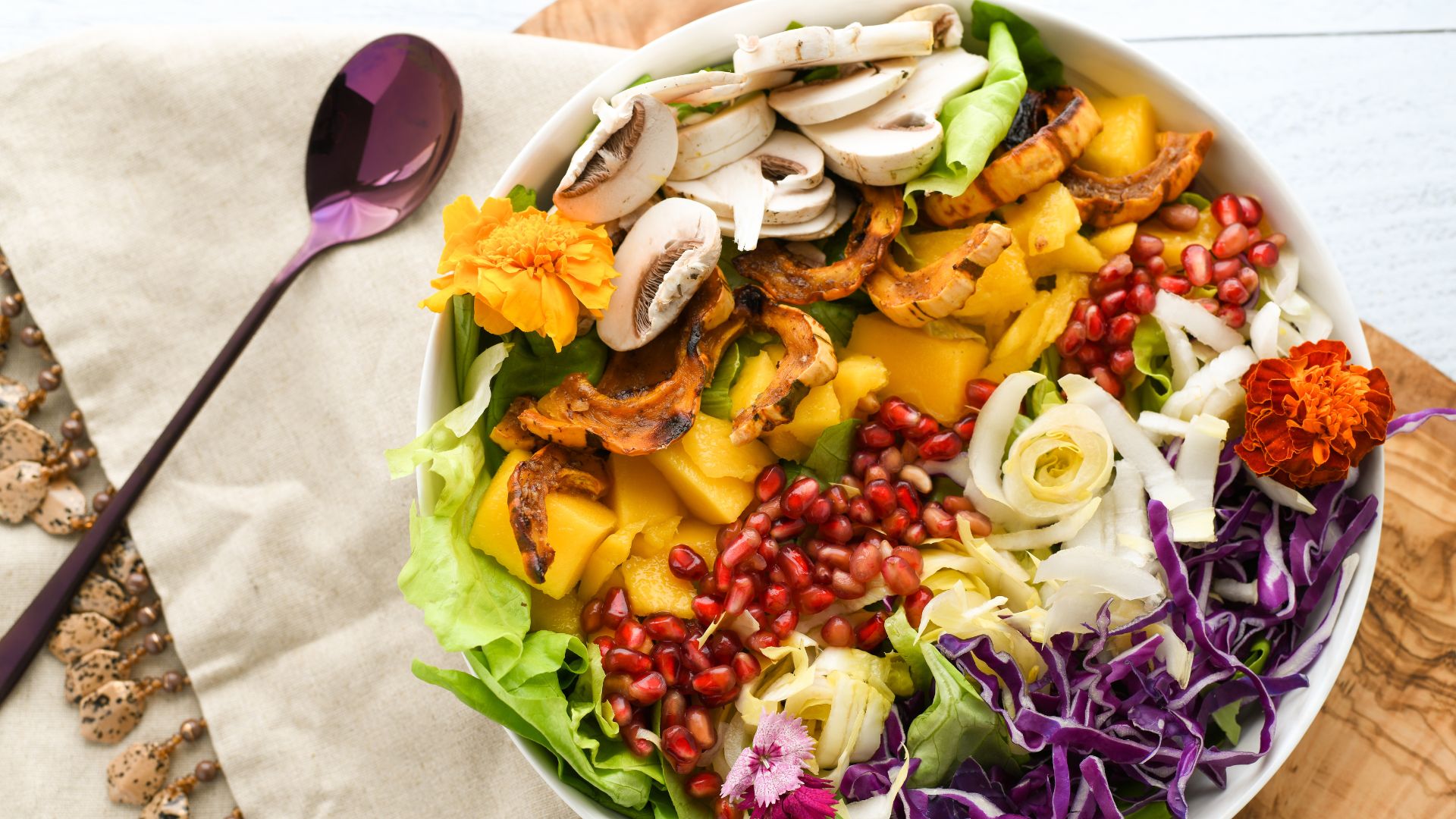Salad: The main dish

While a salad often precedes the main course in restaurants, a salad can also serve as the main course. Salads are wonderful main dish options, especially in warm weather. They are cold, refreshing, and quick to fix.
Knowing how to create a main dish salad that everyone will enjoy is a valuable skill. A main dish salad should include all the components of a meal. Use the MyPlate model to build a main dish salad with a sensational combination of scrumptious ingredients that are delicious, nutritious, and visually appealing. Salads are a great way to get your daily servings of fruit, vegetables, protein, grains, and dairy throughout the day. Making sure to include a variety of foods helps give the salad both the nutrients and the flavor that our bodies crave. Follow these guidelines to create a hearty salad.
Salad greens
Use about two cups of salad greens per person and place them on a plate as a base for building the salad. These can be premixed salad greens, or you can use any combination of salad greens you like. All greens contain healthy nutrients, fiber, antioxidants, vitamins, and minerals. What kind of lettuce or leafy greens will give you the most nutritious bang for your buck? Kale, spinach, beet greens, Swiss chard, romaine, and leaf lettuce are some of the more nutritious types of greens. Iceberg lettuce may be the most popular of all the salad greens, but it’s one of the least nutrient-dense. Fresh herbs add another flavor dimension. Add them whole or use them in the dressing.
Fruits and vegetables
Next, add about a cup or two of other vegetables and fruits. A few examples of vegetables include artichoke hearts, bell or hot peppers, broccoli, carrots, cauliflower, cucumbers, onions, radishes, and tomatoes. If you tend to use only raw vegetables, try varying your approach by using roasted, grilled, marinated, or pickled vegetables for added variety.
Adding fruit creates a bit of sweetness to the salad. Try incorporating apples, berries, cherries, mandarin oranges, melons, peaches, pears, pomegranate seeds, or dried fruit as toppings. In addition, fruit can be blended into dressings.
Protein
Now it is time to add some protein. A combination of animal protein and plant-based protein can be used. Examples of animal protein include cooked meat, poultry, fish, seafood, lunch meats, or hard-cooked eggs. A few plant-based protein options include beans, legumes, lentils, tempeh, tofu, and nuts. Try nuts raw, roasted, candied, toasted, or slivered. Keep in mind that nuts are high in fat, so use them sparingly. Adding leftover proteins to a salad is a great way to repurpose leftovers.
Grains
While croutons are an obvious choice, the sky’s the limit. For crunch, add crumbled pita chips, corn chips, tortilla strips, or toasted ramen noodles. Also consider cooked grains such as barley, bulgur, pasta, quinoa, and rice. If you’re tired of lettuce-based salads, try making a grain-based salad. Another idea is to serve salad with a whole-grain roll or whole-wheat tortilla.
Dairy
There are many cheeses available. Read the nutrition label to find those that are lower in fat. Add cheese, either crumbled, grated, shredded, sliced, or cut into bite-sized cubes.
Dressing
Drizzle a small amount of your favorite homemade or store-bought salad dressing. Have at least two salad dressing options on hand to keep things from getting monotonous.
Create the ultimate salad bar at home. It can be scaled to feed a huge crowd or made for a family dinner. A salad provides younger family members an opportunity to assemble their favorites. Research has proven that children are more receptive to vegetables and fruits when they have the opportunity to choose their favorites, such as through a salad bar, and make those selections themselves.
If you are setting up a salad bar, it can be very helpful to have some combinations in mind to ensure you have enough to make a well-rounded salad.
Here are a few popular salad combinations:
Italian Chopped Salad
Italian salad mix
Protein: salami, pepperoni, prosciutto, white beans, chickpeas
Veggies: Black olives, bell peppers, cucumber, marinated artichoke hearts, mushrooms, onion, tomato, etc.
Marinated mozzarella, Parmesan, provolone cheese
Garlic croutons
Creamy Italian dressing
Taco Salad
Romaine and iceberg lettuce mix
Protein: ground beef, shredded chicken, pulled pork
Veggies: avocado, black olives, jalapeno peppers, onion, pinto or black beans, tomato
Marinated mozzarella, Parmesan, provolone cheese
Crumbled tortilla or corn chips
Salsa, sour cream, or Mexican crema
Dressing: avocado, chipotle ranch, cilantro lime
Mediterranean Salad
Romaine lettuce with shredded red cabbage
Fresh dill, mint, and oregano
Cooked shrimp
Veggies: avocado, English cucumber, garbanzo beans, kalamata olives, marinated artichokes, pepperoncini, radish, red onion, roasted red pepper, tomatoes/sun-dried tomatoes
Cooked orzo
Feta cheese
Toasted chickpeas
Salsa, sour cream, or Mexican crema
Greek dressing or vinaigrette
The biggest obstacle to taking a salad to work for lunch is keeping it cold. This can be accomplished by packing your salad with a frozen bottle of water or a reusable “chill pack” from your freezer.
The key to any main course masterpiece salad is to get creative! Don’t be afraid to play around with textures and flavors. Up your salad game and learn to enjoy eating salad for any meal!
(Sources: fdc.nal.usda.gov; fruitsandveggies.org; myplate.gov)
Vicki Hayman is the Community Vitality and Health educator at UW Extension Weston County. Contact her at vhayman@uwyo.edu”vhayman@uwyo.edu.








